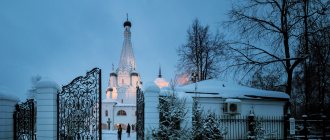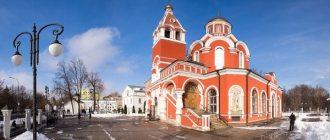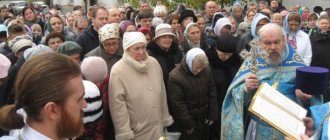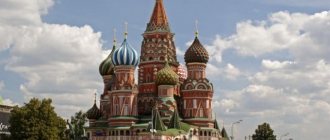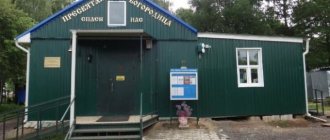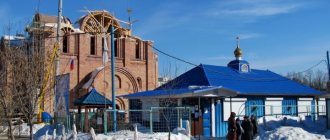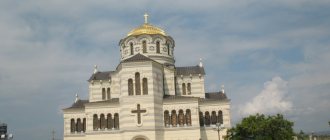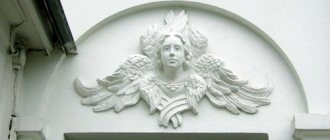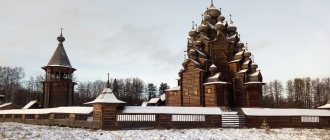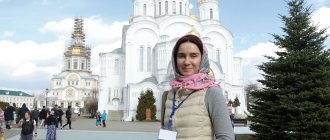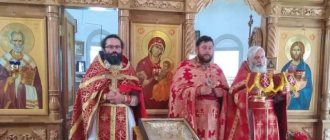In the heart of Russia - Moscow - there are many ancient churches housing Russian Orthodox shrines. Each of them has its own history and its own soul. This is the Church of the Intercession of the Most Holy Theotokos in Bratsevo: modest and simple, but very bright, cozy, always ready to open its doors and help people.
History of the temple
The history of the parish is inextricably linked with the history of the Bratsevo estate, which is an architectural monument of the 17th-19th centuries.
History of the estate in Bratsevo
The very first documentary information about the estate dates back to 1565. It was at this time that Danila Grigorievich Fomin bequeathed this estate to his wife by spiritual charter, and after her death to the Trinity-Sergius Monastery.
For a short time the village of Bratsevo belonged to the monastery. Since 1618, its owner was the clerk A. Ivanov, and since 1626 the Astrakhan governor A. Zubov became the owner of the estate. Then the village passed to A.M. Supneva, who sold it in 1657 to the boyar Bogdan Matveevich Khitrovo, an official, courtier, large landowner, and military leader.
Construction and foundation of the church
The Church of the Intercession of the Blessed Virgin Mary appeared thanks to B.M. Khitrovo. It was under him that the estate stone church was built in 1672.
Having built a temple in Bratsevo, Bogdan Matveevich supplied it with wonderful icons and utensils, most of which came from the workshops of the Armory, which was the center of artistic and industrial services for the Tsar’s court and gathered the best artists of that time.
Historical fate
After Khitrovo, the village was owned by the Naryshkins, and later by the Stroganovs, under whom a new estate ensemble was built according to the design of the architect A. Voronikhin. In 1840, the building was restored in the Romantic style. This happened under the owner Ladomirsky.
In 1922-23, all church valuables were removed from the parish. In 1934, on the initiative of Soviet workers of the Progress factory, the parish was closed, the domes and bell tower were destroyed. After changing the interior, it housed a dye factory, a service station and storage facilities. At that time, the parish school building was occupied for housing, and a store was located in the gatehouse.
Restoration and current situation
In 1990, the church was finally returned to the Orthodox believers, and in January 1993, services resumed there. By 2000, large-scale restoration work had been carried out.
Currently, the Church of the Intercession of the Blessed Virgin Mary in Tushino is operational. It is open daily. Divine services are held here every day. The temple also includes several chapels, where services and prayer services are also held.
Story
The building of the shrine is associated with the Bratsevo estate. By the way, this area was first mentioned in 1565. The plot did not belong to the widow Danilova, then it was sold to the boyar. After which it was sold many more times. The date of construction is indicated by a slab made of stone. It is on her territory.
The sacred building was erected by a boyar and a gunsmith. First, the slab was installed on the territory of the shrine, then it was kept for some time in the building of the Intercession Church in Bratsevo. And only many years later, it was returned to its original place. To this day, the building itself has not survived in its original form. It was rebuilt and reconstructed several times.
The best article for you, go to: Church of the Resurrection of the Word in Bryusov Lane
So, like many churches, it was closed during Soviet times. Part of the building was dismantled. After some time, there was a workshop in its premises where dyes for fabrics were produced. After the factory, the premises were used as a warehouse. The temple was even used as a service station. And only in the early 90s the church was able to resume its work and began to hold services there.
The modern Church of the Intercession has been completely restored and stands out in Moscow. A refectory was added to it, and a little later the bell tower was restored.
Location of the church in Moscow
The metro stations closest to the temple on Salome Neris are Skhodnenskaya, Tushinskaya, Planernaya and Mitino.
The exact address of the church: Moscow, Salomei Neris street, building 4, building 2.
It is better to get from the metro by transport.
Buses go to the stop “Temple of the Intercession in Bratsevo” (the driver will stop on request):
- No. 267 from Skhodnenskaya metro station;
- No. 777 from Tushinskaya metro station;
- No. 267 from Mitino metro station.
You can get to the Bratsevo stop by bus:
- No. 43, 212 from Tushinskaya metro station;
- No. 173, 88 from Planernaya metro station.
You can also get to the church by car. There is a small parking area near the temple fence.
Description
After construction was completed, the Church of the Intercession of the Blessed Virgin Mary amazed its contemporaries not only with the beauty of its architecture and style, but also with its rich interior decoration, on which the best craftsmen and artists of the Armory worked. They also painted the iconostasis, which is now kept in the Tretyakov Gallery in Moscow.
The Church of the Intercession of the Blessed Virgin Mary in Bratsevo is a pillarless temple, made in the form of two-light quadrangles, which are covered with a closed vault. It is crowned with a classic Moscow five-domed church, decorated in turn with tiers of kokoshniks.
A refectory and a tented bell tower were built on the western part of the temple, on which the so-called fighting clock was installed, which was a real curiosity for that time.
The church was decorated with a whole belt of multi-colored tiles. The cornice is also decorated with tiled images of angels with wings. The belt itself is a set of rectangular tiles, the covering of which is a multi-colored glazed ornament made in the form of rosettes.
On a white background in the tympanums of the kokoshniks, unique, protruding reliefs of angels with blue wings are clearly visible. It is worth noting that it was the appearance of multi-colored tiles and horubim that made the Church of the Intercession in Bratsevo exquisitely elegant, despite all its modesty.
Architecture and decoration of the temple
The church is not unique in its architecture; there are many similar buildings in Moscow and throughout Russia. However, some decorative elements of the building, made by the best masters of the Armory of that time and surviving to this day, cannot leave a person with artistic taste indifferent.
Appearance
In those days, small pillarless churches in the form of double-height quadrangles with two rows of windows were common. This is what this building is like. Compact, crowned with the classic Moscow five chapters and tiers of kokoshniks. The outside of the temple is modestly decorated and decorated with colorful tiles. They give a rather simple structure an elegant elegance.
Previously, the building was adjoined from the west by a bell tower and a refectory, and from the east by a three-part apse. In 1887, a chapel was added to the north in honor of Tsar Alexei Mikhailovich; later it was renamed in the name of St. John Chrysostom.
Today there is no bell tower in the church, which is a disadvantage for the modern appearance of the church. However, there is talk of its restoration.
Throughout its existence, the temple building underwent changes. However, now it has already been cleared of most of the layers of later times. Of the 19th century heritage, only the northern aisle remains. The windows returned to their original frame and size, the covering of the kokoshniks was restored, and the columned portico around the altar was removed.
Interior design
It is now difficult to judge the internal situation that was here originally. In 1917, all the interior decoration was lost, and since 1990 it has been recreated. In the central building, work is underway on a four-tier iconostasis. The first three rows are already filled with icons. In the chapel, the iconostasis consists of two tiers - local and festive.
The interior design of the temple cannot be called smooth. On the one hand, there are very good local icons, on the other hand, the impression is spoiled by the frankly poor painting of the vaults, which, due to the dark color palette, lowers the already low ceiling. The icon cases are also devoid of monotony of style. In some places they are carved wood, in others they are clearly carpentry, in others they are made to resemble marble.
Temple shrines
One of the main shrines of the church is the miraculous icon of the Mother of God “The Inexhaustible Chalice”.
It is believed that the “Inexhaustible Chalice” first appeared to the world in Serpukhov, and later similar icons began to be created in other places in Russia. One of these images is also in the brotherly parish.
The icon is considered an inexhaustible source of help for those who are sick with alcoholism, who are irresistibly attracted by the passion of drunkenness. Possessed by this passion, their family and friends resort to this miraculous image with prayers for healing from illness, as well as to thank the Mother of God for her mercy and help in healing.
The temple contains particles of the relics of many revered saints:
- St. bliss Matrona of Moscow;
- St. Basil the Great;
- St. Sergius of Radonezh;
- svschmch. Charalampia;
- Bethlehem babies;
- St. Joasaph of Belgorod;
- St. Neil Stolobensky;
- a piece of the vestment of St. Luke Voino-Yasenetsky;
- particle of the coffin of St. Seraphim of Sarov.
Parishioners turn to all these shrines with prayers for help.
Divine services
The Church of the Virgin Mary is open to everyone. The Divine Liturgy is served every morning, and the Evening Service is held at 17.00.
On Wednesdays, the Akathist to the Intercession of the Most Holy Theotokos is read in the church. At this service, prayers are offered for the well-being and salvation of children, grandchildren, godchildren, so that the Mother of God will shelter them from troubles and illnesses.
On Saturdays, an akathist is read before the icon of the Mother of God “The Inexhaustible Chalice.” At this time, those who want to get help in getting rid of the desire for drunkenness come. They pray for themselves and their loved ones who are addicted to alcohol.
Shrines of the temple and schedule of services
It is believed that the icons for the church iconostasis belong to the brushes of different artists. The temple is proud of its main attraction - the miraculous icon of the Mother of God Hodegetria (Smolensk).
In addition, there is a particle of the coffin of St. Seraphim of Sarov, as well as particles of the relics of St. Sergius of Radonezh, Nile of Stoloben, the Bethlehem babies and other saints.
For those wishing to visit the temple in Bratsevo, here is the schedule of services: Liturgy on Wednesday, Friday and on holidays begins at 8.00, on Saturday - at 7.30, on Sunday - at 8.30, and on the eve of the holiday - all-night vigil at 17.00.
Temple Sunday School
The parish ministers carry out active social and educational work. Their activities are not limited to just holding services. They also try to diversify the leisure time of their parishioners.
At the temple there are:
- Sunday schools for children and adults.
- Gospel reading groups.
- Orthodox lecture hall.
- Youth club.
- Photo school.
- Sunday tea parties.
Sunday schools do not have a unique history. They have been created in our time so that every Christian can come here for advice and education, find like-minded people and spend time in their circle.
Work of the establishment
In the parish school, children are taught the Law of God. They try to present it in an interesting and accessible form for children. During the classes, children not only come into contact with Orthodoxy and receive spiritual education, but also simply communicate with each other. Church ministers try to make communication with young parishioners easy, bright, and not boring. With the children they draw, sculpt, make crafts, sing, read poetry, organize concerts and tea parties.
Sunday school classes for adults are held in the form of an Orthodox lecture hall. Lectures are held weekly on Saturdays or Sundays on a variety of topics that are useful and interesting for parishioners. The range of topics is extremely wide: from family interaction and childhood addictions to the history of the Last Supper.
Also, at the Sunday school, courses on Liturgics and the study of the Holy Scriptures (Old and New Testaments) are constantly held, which any adult can take if desired.
